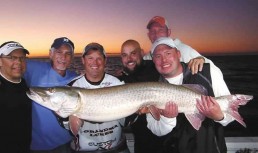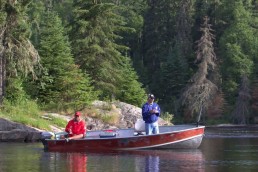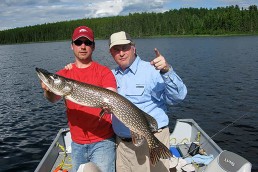Three ways to Catch Fall Muskies on Lake St. Clair
Lake St. Clair has the second most registered muskies of any lake listed in Muskies, Inc. The lake is the best body of water for numbers of fish in the 30- to 40-pound and 50-inch ranges. This is a relative “dishpan” of a lake, with 26 by 24 miles of open water—260,000 acres—with an average depth of 11 feet, and the deepest levels at approximately 21 feet.
Where on earth do you begin?
Then you add in the Detroit River at 28 miles long and the St. Clair River at 40 miles long, and you get the largest freshwater delta in North America on the north end of the lake. What a beast. But in talking about the lake proper, we have to decide what are we going to do: cast, jig or troll?
There is probably no body of water where a good guide or charter wouldn’t cut the learning curve more than this one—and I’ve fished all the trophy muskie haunts from east of Montreal to Winnipeg and from Lac Seul to West Virginia. There are many good guides and charters available for casting, jigging or trolling.
First, we better find the fish and there is no better way to than by covering water with multiple lines and trolling at 3.5 to 5 mph. And, it’s also important to know the dynamics of Lake St. Clair.
It is fed by Lake Huron, which in comparison is a giant with clear water that warms up and cools down slowly. It’s also been said that Lake St. Clair would drain in less than a week if they damned up the St. Clair River (Yes, 260,000 acres would drain into the Detroit River in less than a week). There is a lot of current in certain areas of the lake, so essentially we are also looking at a giant wide “spot” in this river. There are a series of other incoming creeks and rivers feeding the lake as well.
Lake St. Clair is border water with Ontario. There is not a reciprocal license agreement. If you want to fish Michigan, then you need a Michigan license; if you want to fish Ontario, you need an Ontario fishing license. (Also, if you are fishing on Indian Territory, you will need their Walpole Island license—this area is an Island complex on the north end of the lake.)
When the water temperature in Lake St. Clair dips into the mid- to lower-60 degree range, obviously it is the season where your period of light is less. The bait starts breaking up from their summer and early fall areas and starts moving shallow. (Remember, shallow is relative in this giant “dishpan.”) The fall is a great time for the trophy fisherman, as fish are really putting on the feedbag and metabolizing food slower. As the fall progresses the muskies collapse on the bait as it slowly moves into the shallows.
For tackle, I use Custom X trolling rods, 40-pound-test Hi-Seas Grand Slam monofilament, Stealth tackle 80-pound trolling leaders, Church Tackle’s TX-44 boards, homemade double planers and offshore snap-on weights. For rod holders and masts I use Down-East rod holders for the boat rods and Bert’s Custom Tackle rod trees for the board rods. For reels I use the Shimano 700LCs for my board rods and the Daiwa Sealine, Shimano 600LC and Penn 320 for the boat rods.
On St. Clair, we generally don’t need a lot of line on the boat rods, as we run the baits close to the boat and board rods may go out 80 feet to get to the board itself, then back another 15 to 100 feet behind. So a bigger reel is recommended.
As far as baits, we need lots of them and in every color. Early fall is a transition time and they will hit small to large bait, jointed bait, straights and bucktails. As the water temperatures drop into the low 50s, we are usually running 8- to 13-inch baits. Some of the common trolling baits on Lake St. Clair are from Spanky, Ziggies, Blue Waters, Muskie Train MX6 and MX9, Boss Shad, Hammer Shad, Nils Master, K&J Magnetics and gobies, Jakes, Grandmas, Stiletto, Wiley, Musky Armor, Tuff Shads and Masons, just to name a few.
The lake’s clarity can vary significantly from one area to another, and with the current it can change during the day. It is great to have an assortment of different colors. For clearer water, natural colors are preferred such as perch, walleye, bass, shad, sucker colors, etc. For murkier waters, use bright baits on bright days and dark ones on overcast days. So FireTiger, Orange Tiger, Clown, Cobra Perch, Black Perch, and different frog patterns can be vary effective.
As it gets colder there are large areas on the Canadian south shore and Michigan shorelines that will hold fish. I like gridding from shallow to deep areas looking for bait. Starting in Anchor Bay, Metro Point, Clinton River, the mile roads on the Michigan shoreline and the entire South shore, these locations can heat up from Peche Island, Pikes Creek, the Puce, Belle, Ruscom and Thames rivers and Stoney Point. Any “off-colored” water you see is preferable to clear water, as the muskies seam to feed better in the off-colored water for a variety of reasons. Keep the baits relatively high in the water column and very your lengths from short lines near the boat to the longest being on the outside board. As soon as you contact a muskie, mark it on your GPS and work the area thoroughly. Muskies were likely just there. Try baits with similar colors, action, and get them around the same depth of water as your first fish and hold on.
Before trying Lake St. Clair, be sure to have good safety equipment on the boat, GPS and a ship-to-shore radio. It is a large body of water and can get dangerous quickly. And for the muskies, a good net such as the Magnum Drifter, good hook-out tools and Knipex cutters are best. Remember, it is a fragile resource, so for the fish, “let them go, let them grow.”
MWO
SHARE THIS POST
You may also like...
Did you enjoy this post?
You can be among the first to get the latest info on where to go, what to use and how to use it!
Matt Firestein
MidWest Outdoors works with more than 200 outdoor experts each year, who contribute articles based on their areas of expertise. MidWest Outdoors magazine offers more fishing and hunting articles than any other publication!




